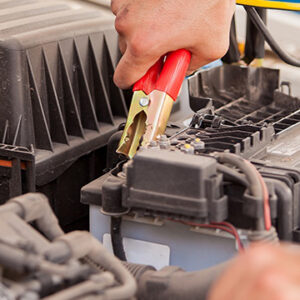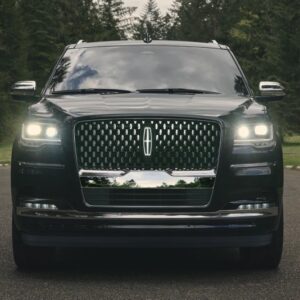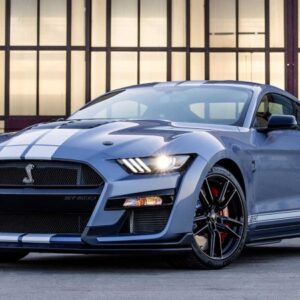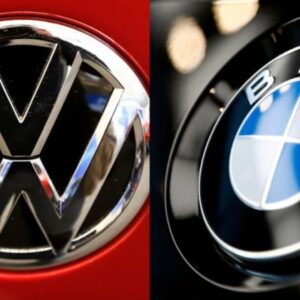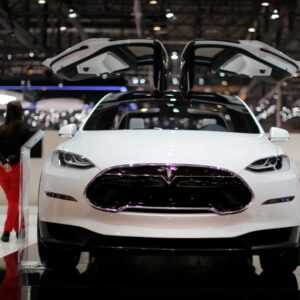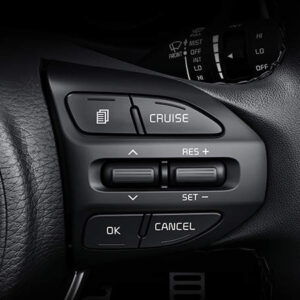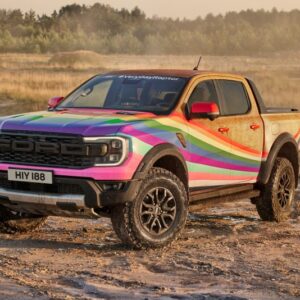What diesel engine does Ford use? Ford’s diesel trucks have been popular with customers for decades. But when it comes to reliability, torque, and power, what is the best Ford diesel engine? Like other vehicle manufacturers, Ford has had some good and bad years. Here, we’ll take a look at some of the best diesel engines that Ford has released, as well as some that are better off being avoided.
What Diesel Engine Does Ford Use?
Throughout the last 35 years, Ford has made several excellent diesel engines.
6.9L IDI Diesel V8
The 6.9L was a naturally aspirated indirect injected V8 that debuted in the fall of 1982 (‘83 model). Offered as a $2,225 option, the cast iron engine was made for three-quarter-ton trucks and higher Ford pickups. The first 6.9L diesel produced an output of 170 hp and 315 lb/ft torque, which provided an excellent low-end ability for towing and hauling.
The plans for Ford’s first diesel engine started several years before the introduction of the 6.9L. As early as 1977, IH and Ford had worked on the designs for a light-duty diesel, (the project was considered top-secret) before finally approving the final schematics in 1979. (Chevy and Dodge had rushed their diesel motors into production, creating huge issues, and IH was not about to make that mistake).
There were over 160 prototypes built, and in the summer of ‘80, several engines were produced and field tested in trucks all over the country (over 813,000 miles of testing). Finally, in the summer of ‘82, the new diesel power plant rolled off the Twin Cities assembly line and soon after made its way to all the Ford truck production lines.
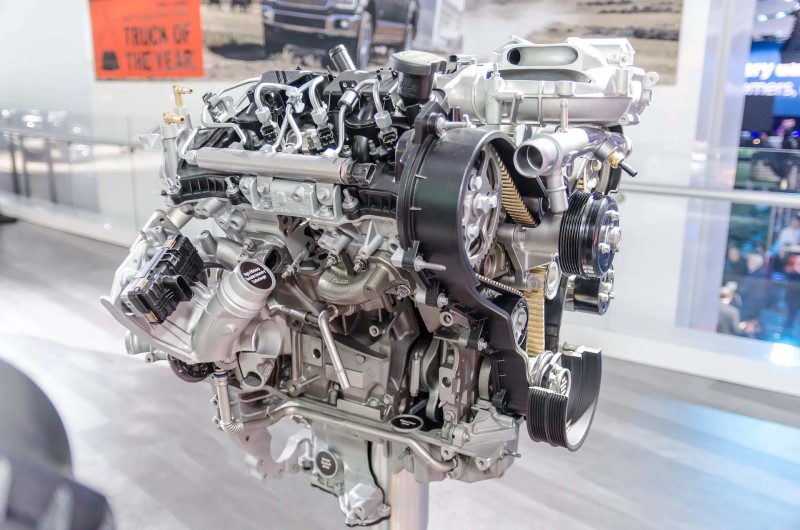
The engine probably would have been brought into production sooner had International Harvester not experienced such internal company chaos during the late 70s. In 1979, the workers at International Harvester went on strike for 172 days (primarily in response to the company chairman’s cost-cutting measures). When work resumed in April 1980, the company was so battered that it could never regain its former glory.
The design of the new diesel engine borrowed heavily from the MV404 (one of the last V8 engines Harvester made). The 6.9L was designed with a cast iron casing, which provided rigidity and structural integrity. The bore was smaller than the previous 6.6L V8 and just a bit smaller than the MV404. The smaller bore size helped the engine work more effectively, providing better fuel economy and increased low-end power.
The IDI engine relied on oil-cooled pistons, a massive forged crank with 2.2-inch rods, and a gear-driven cam. The injection pump was a Stanadyne DB2 rotary pump operated through a separate chamber to mix air and fuel. The compression was adjusted after the first year to 21.5:1 after some issues with cold starting were reported.
When the engine first appeared, it was paired with T19 BorgWarner 4-speed manual or Ford’s C6 SelectShift 3-Speed Automatic transmission. (a four-speed manual and the option of a -speed automatic. During its tenure until 1987, the engine also appeared with a five-speed manual.
The 6.9L lasted until 1988, when Ford introduced the 7.3L IDI engine. During its run in the mid-eighties, the IDI diesel found its way into F-250s and F-350s and heavy-duty E-series vans.
7.3L IDI Engine V8
In 1988, buoyed by the success of the 6.9L, Ford offered a 7.3L IDI diesel V8. Even though the engine borrowed heavily from the previous version with its cast iron case and heads, the 7.3 did have some significant changes. Namely, the bore diameter was increased to 4.11, and IH installed stronger, more robust pistons. An enlarged pre-chamber allowed for better mixing of the fuel and air, and a reinforced front cover was added to better battle oil leakage. A few other minor changes were made, the result was a motor with 185 HP @ 3,000 rpm and 315 lb/ft torque.
The engine was paired with the five-speed ZF S5-42 manual transmission, and had an option for the C6 three-speed Select-shift automatic.
Ford turbocharged the 7.3L in 1993, but while the upgrade created additional horsepower and torque, it was replaced shortly thereafter with the 7.3L Powerstroke engine.
The indirect injection allowed truck owners to save fuel. While they weren’t as efficient as modern direct injection systems, they were considerably better than gas-guzzling V8s at the time. With gasoline prices rising, diesel fuel was still cheap enough to warrant their serious consideration, and that was exactly what Ford was counting on.
7.3L Powerstroke V8
Many classic truck restorers consider the 7.3L Powerstroke the absolute best diesel engine ever made by Ford. It was produced from 1993 – 2004 as Ford’s version of the Navstar T444E turbo-diesel. Although the displacement is the same, the engines are nothing alike. Navistar set its mind to beefing up almost every component of the engine, from increasing the bore width to 4.11 with a large stroke of 4.18. The rods were fashioned of forged steel, strengthened to help keep the motor’s cycle intact.
The HEUI (Hydraulically actuated Electronic-controlled unit injector) was powered by an HPOP (High-pressured oil pump) to help provide a complete burn inside each chamber. With the exception of a catalytic converter, the 7.3L had little emissions control influences, which later Powerstroke engines would be required to include.
This powerful engine produced 275 hp and over 525 ft/lb of torque, which makes it one of the most powerful engines Ford had ever made.
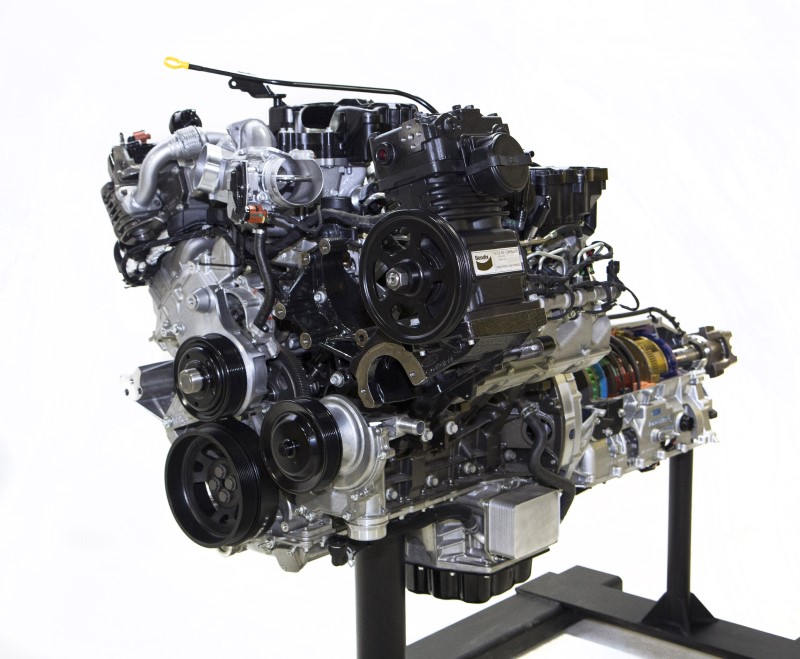
The Powerstroke was encased in a cast iron block and heads, lending to it being virtually indestructible. Owners found the Powerstroke able to take the abuse of off-road applications, cruising over rough, rocky terrain, which only helped to increase its popularity.
The engine was electronically injected (unlike the previous IDI engines that used a pre-chamber to mix fuel/air). The low compression of 17.5:1 offered excellent power in the lower gears, which made this truck the perfect one for agricultural and construction work, where towing and payload were vitally important.
The engine was paired with a six-speed ZF S6-650 manual transmission or the option of the 4R100 four-speed automatic.
It is not unusual for this Powerstroke engine to run almost 500,000 miles. Many restorers have found trucks with 200,000 miles on them for their projects, and these units are demanding good money. Many of these older trucks can be found online between $20k to $30k.
6.7L PowerStroke V8
The 6.7 PowerStroke made its appearance in the 2011 Ford Super Duty, replacing the previous 6.4L PowerStroke. This engine was the first Powerstroke engine developed by Ford, who exchanged the cast-iron block of previous generations for a compacted graphite iron block to reduce the weight and boost fuel economy. The engine had aluminum cylinder heads with multiple direct fuel injectors per chamber responsible for delivering fuel into the piston bowl.
Ford developed the 6.7L primarily in response to the negative feedback it received on the 6.0 and 6.4L (which are widely considered the worst Ford diesel engines ever made).
When first developed, the output of the 6.7 engine was 390 HP with 735 lb/ft of torque. (Ford tweaked the engine in 2000 and again in 2015, 2017, 2018, and 2020 to achieve more power). The 2015 version produced 440 HP and 860 lb/ft of torque, which at the time was a considerable improvement over other diesel engines.
Unfortunately, Ford Motor Company’s competitors were not to be outdone. Over the next few years, Ford would enter into a horsepower race to compete with the Chevy Duramax and the Ram Cummins diesel motors, who were continually developing greater power levels. Eventually, Ford would raise the power levels in 2020 to 475 hp and 1020 lb/ft of torque, which Dodge and GM couldn’t match.
The fuel economy of the 6.7L was decidedly better than previous engines, and the increased power outputs delighted Ford truck owners everywhere. The towing capacity of the trucks has steadily risen over the years so the 2022 Powerstroke Turbo Diesel pulls 20,000 lbs up to 22,500 lbs with a gooseneck or fifth wheel hitch.
Are There Ford Diesel Engines To Avoid?
Even though Ford has made several quality diesel engines, some have less-than-perfect track records.
6.0 Powerstroke
The worst decision that Ford ever made was to discontinue the 7.3L that seems to have captured the hearts of truck lovers nationwide. The 6.0-liter power stroke V8 was less powerful, consumed more gas, and had severe electrical problems. Common complaints were dealing with the oil cooler, EGR, and turbocharger failure, all of which affected the performance of the truck.
Owners were disgusted with the diesel engines constantly breaking down or having to empty their bank accounts just to fill up the gas tank. (By this time, the price of diesel fuel had caught up and surpassed that of a gallon or regular unleaded).
As Ford service centers started piling up with broken-down Ford trucks and mechanics fell further and further behind, consumer anger grew proportionately. When several class-action lawsuits were filed, Ford lost in an appeals court when it was determined that the company had committed fraud in selling the diesel. (Ford would turn around and sue Navistar for $493 million).
6.4L Powerstroke
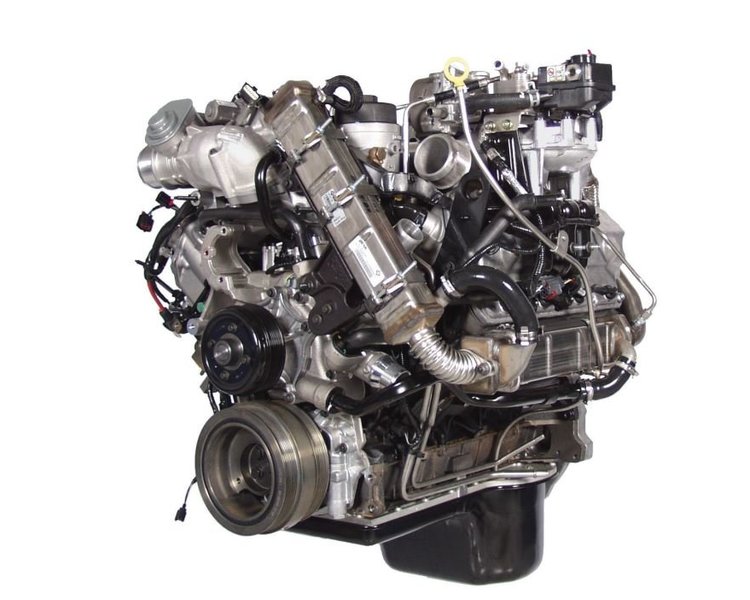
The company tried to salvage what it could with the development of the 6.4L diesel, but it wasn’t much better than the previous 6.0. What had been the most reliable diesel engine on the planet (7.3L), was now a pitiful shell of its former self. Ford owners began to abandon the brand in droves, and Ford felt obligated to go to the drawing board again.
Common issues in the 6.4L were broken pistons, emissions issues, block manifolds, and fuel injector failures. Most engines from these years are not worth the money you might pay, despite the availability of aftermarket parts. (Many restorers will tell you that the best thing you can do with a 6.4L Power Stroke is to run away from it as fast as you can).
Before The Power Stroke
There were many different engines before the power stroke showed up, including the incredibly important 6.9-liter International Diesel Engine. This is back when it was common for engine blocks to be made from cast iron rather than aluminum alloy. While this engine is dated, this by no means should contradict its power. The 6.9-liter naturally aspirated diesel engine was able to produce up to 340 pound-feet of torque back in 1982.
By 1988, this engine had an increase in size, reaching 7.3 liters. After testing the waters with this stronger engine for a few years, the final design came out in 1993 using turbocharged technology rather than natural aspiration. While these engine designs are less eco-friendly and efficient today compared to our current engine technologies, the International Diesel Engine is still up and running on many 1980s Ford trucks today. (This is partially thanks to its strong, heavy-duty cast iron engine block).
In order to compete with successful rivals, Ford had to up the ante, which is where the first power stroke engine comes into the picture––the 7.3-liter power stroke. This engine is the one that took Ford to the top. Ford went from producing a max of 388 pound-feet of torque to being able to reach 525 pound-feet of torque, thanks to this engine.
The Power Stroke’s Dark Days
The 7.3-liter Power Stroke engine was certainly a favorite among diesel truck drivers; that said, its practicality waned over time due to harsher emission restrictions and developing technologies. As a result, Ford decided to make a new engine––the 6.0-liter Power Stroke diesel. Unfortunately, this engine did not perform well in comparison to the competition or past power stroke engines. Developers tried increasing the power a bit with the 6.4-liter Power Stroke, but to no avail. This is where the bad reputation for power strokes came in. The catch here is that this engine didn’t last for long, only ranging from 2004 to 2010. So, the power stroke engine you know today is a completely different (and better) engine.
How The Power Stroke Rose Above The Ashes
Up until now, all of Ford’s power stroke engines were developed with International (now known as “Navistar”). The company really wanted to tower above the competition, and that was proving impossible if they kept their partnership with Navistar. In 2011, the Ford-built 6.7-liter Power Stroke engine came to life, producing as much as 735 pound-feet of torque right out the gate. By 2017, this same exact engine could pump out up to 925 pound-feet of torque and tow as much as 21,000 pounds.
The Most Powerful Power Stroke Diesel Engine Yet!
Think that’s impressive? The newer F-350 Super Duty trucks (2020 to 2022) can tow up to 35,750 pounds with the 6.7-liter power stroke turbocharged V8 engine. To put this into perspective, the 6.9-liter International Diesel Engine that we talked about earlier could only tow up to 9,800 pounds. While that’s impressive for its time, Ford has come a long way with their powerful engine technologies and designs to create the reliable yet powerful engines that we use today.

Pick Out Your Used Ford Diesel Truck Now!
Now that you can see why the power stroke got such a bad rep and how short-lived its “bad days” actually were, you can visit your DePaula Ford knowing that 2011+ Ford diesel trucks are safe to purchase. Let’s take a closer look at a few great Ford SuperDuty options.
An Older Pick: The 2013 Ford Super Duty
If you’re looking for a used truck and you’re on a budget, you might want to consider an older model like the 2013 Super Duty. This truck is available in F-250 and F-350 models, but if you’re looking for the highest towing capacity, you’ll want to choose an F-350. This particular model year is capable of towing up to 14,000 pounds, producing up to 800 pound-feet of torque. Plus, it’s not tech-free just because of its age. You’ll still get a touchscreen infotainment system, Hill Start Assist, and Trailer Sway Control. Plus, you’ll get to choose from several different trim levels, including the beloved King Ranch and Lariat trims.
A Middle Ground: The 2017 Ford Super Duty
While our next truck does have some age on it, making it more affordable, it’s also new enough to have pretty much any tech features and capabilities you’ll ever need. The 2017 Ford Super Duty truck offers the newer 6.7-liter turbocharged diesel engine. This means that the F-350 can tow up to 21,000 pounds conventionally and up to 32,500 pounds with a gooseneck hitch.
Thanks to modern technologies, the 2017 Ford Super Duty includes more standard features, such as an SOS Emergency Crash Response system, tire pressure monitoring for both the truck and the trailer, and seat tethers for children. There’s also an available Trailer Reverse Guidance system to help out when you’re backing up your trailer. No matter which trim you choose, you’ll also get features like an easy-up tailgate and adjustable lumbar support. As you upgrade trims, you can access other standard features such as automatic climate control and in-dash Navigation.
The Newer Used Model: The 2020 Ford Super Duty
Looking for a new, used model? Then the 2022 Ford Super Duty is your best bet. This model has the powerful 6.7-liter Power Stroke V8 Turbo Diesel engine that can tow up to 35,750 pounds when you opt for the F-350 version. This model produces a whopping 1,050 pound-feet of torque, so you can rest assured that hills and inclines are easier to climb than ever before. In addition to its vast power, this used diesel truck is also your best bet for technology. You can access features such as Pro Trailer Backup Assist, which helps you line up your hitch to your trailer. This technology also makes it easier to back your trailer up, thanks to cameras and sensors.
If you want a tow-capable truck that’s also off-road savvy, that’s all the more reason to stick with the 2020 Super Duty. This truck is the first Ford Super Duty to offer the Tremor Off-Roading package, adding a 10.4-inch ground clearance rating, a 33-inch water fording maximum, and most importantly, Trail Control. Thanks to Trail Control, you can choose from several different drive modes depending on the current road conditions. This includes a Rock Crawling mode.
Final Thoughts on Choosing the Right Model
It’s easy to see that as your Ford diesel truck dealer, we’ve got a lot of different options to offer. Whether you want an older model, a newer model, or something in between, we’ve got options! If you’re not quite sure where you fit, we’re here to help you decide. When it comes right down to it, what matters most is your lifestyle and your budget. These and other factors to do with personal preference will determine which make, model, and trim you need. The good news is that everyone here at DePaula Ford is knowledgeable about Power Stroke engines and the differing Ford Super Duty models. We’re happy to answer any questions you may have about our vast diesel truck selection so you can find the perfect match for your truck needs.
Above is information about What diesel engine does Ford use? that we have compiled. Hopefully, through the above content, you have a more detailed understanding of Are there ford diesel engines to avoid? Thank you for reading our post.
